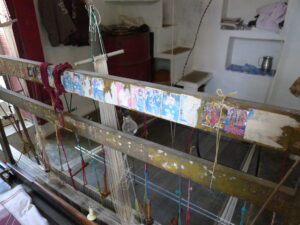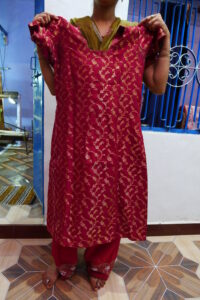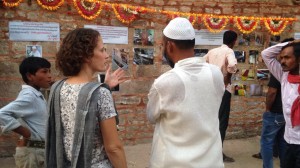Engaged Anthropology Grant: Jane Lynch

While a doctoral student at the University of Michigan, Ann Arbor, Jane Lynch received a Dissertation Fieldwork Grant in 2010 to aid research on “Fashioning Value: Materiality, Cloth, and Political Economy in India,” supervised by Dr. Webb Keane. In 2016 Dr. Lynch received an Engaged Anthropology Grant which allowed her to return to the field and carry out her project, “Beyond Art and Labor: Representing the Everyday Politics of Weaving in India”.
Last summer, I began work on a collaborative project, organized and executed together with textile weavers in a town in Central India. This project emerged as an outgrowth of my dissertation research, substantial parts of which were based in this town, which is famous for the eponymously named “Chanderi” cloth produced there. Many of my collaborators were thus old friends and informants. The focus of our work was to create a temporary “pop-up” exhibition, which aimed to re-envision—and present, as a catalyst for dialogue—the ways in which the practice and process of handloom weaving are represented.

The 34 photographs included in the exhibition were exemplary of phenomena that weavers and traders showed me during my research to explain the work they do, the ways in which business is conducted in Chanderi, and the possibilites for reimagining both. These photographs challenge conventional representations of handloom weaving in Chanderi, which emphasize a predictable, unidirectional technical process. Put differently, they foreground dimensions of the weaving process that at first, appear to be either outside of or deviations from a normal course of production but are in fact integral to the making of cloth. We organized these images into three groups, focusing on: (1) the homes and domestic lives of weavers; (2) the organization of business and profit; and (3) how weavers create value through the reuse of cast-off yarn and cloth. Together, these photographs drew attention to aspects of Chanderi weaving that are often hidden from public view and discourse.

These photographs revealed the work of weaving in Chanderi as part of domestic life. Everyday activities—such as caring for children, bending down in prayer, and counting to see if enough cash has been saved for school fees—are interwoven with the production of cloth. Looms are the foundations of homes in which weaving is the family business. Both the technical skill and business of weaving are learned within families, often while sitting next to a parent (Image 1). Looms also reveal traces of the people who spend long hours sitting in front of them working. The stickers of political parties, cricket players, and gods adhered to their wooden frames offer one example of this (Image 2).

These photographs also documented the organization of business and profit in Chanderi’s weaving industry. These activities are rooted in social values and expectations. One articulation of this is the principal and aspiration of shubh labh, which—in the words of one trader from Chanderi—translates into English as “profit with goodness” (Image 3). These photographs show how account books (i.e., both the ledgers kept by traders and middlemen as well as the small diaries, referred to locally as sargas, kept by weavers) are used to record exchanges of raw materials, finished cloth, and cash (Image 4). We also documented the aspects of the weaving process (e.g., street-warping and the dressing of the loom) that are unaccounted for in these ledgers, but which nevertheless carry a cost, typically borne by weavers.

At the end of each warp, weavers in Chanderi are left with and collect scraps of cloth. They acquire remnants in other ways too. For example, cloth that has been rejected in processes of “quality control.” Such cloth—particularly that which has been put to new use—challenges the representation of weaving as a predictable and uni-directional process with a neatly defined beginning and end. For example, one photograph showed a red salwar suit made from leftover material (Image 5). From the remnants of her own weaving, this weaver stitched the clothing that she wore on her wedding day. Another photograph showed a men’s dress shirt tailored out of “corporate scraps” (Image 6). This cloth had originally been woven as curtains for the retail company, Fabindia, but was rejected during the “quality control” process. Remnants are also used by weavers to give as gifts, to decorate their homes, and save for future needs.

In conceiving of and planning for the pop-up exhibition, I invited weavers and others in Chanderi to participate in the project of re-envisioning and representing the practice and process of weaving. The exhibition was also organized so that it could be viewed freely. Instead of displaying the photographs in a private, interior space, we used a broadly accessible, public space. The openness of the exhibition was, in part, an effort to dispel concerns on the part of some weavers that a more formal event would be dominated by the interests and presence of local traders and middlemen. By using walls in the town’s central market, Sadaar Bazaar, as the site of the pop-up exhibition, we sought to encourage spontaneous experiences of viewing, discussion, and engagement (Image 7). All visitors were invited to ask questions, share their thoughts, and write down their reactions as part of the formal record of the event (Image 8).

By bringing the diverse perspectives of weavers to the foreground, this project aimed to help cultivate more equitable and inclusive conversations about the stakes and significance of handloom weaving. Rather than looking at textiles as they fit with formal representations of their processes of production, the exhibition revealed instances where the purposes and possibilities of cloth were reclaimed, reconceived, and reimagined by weavers. Calling attention not only to what is hidden by conventional representations of the production process, but also to what is imagined in this process, this approach brings to the center of analysis the uncertainty, possibilities, and fantasies bound up in the process of production. As an anthropologist, the “dialogic editing” involved in this project unsettled aspects of my original ethnography, even as it came to ground my new analyses—and imaginings—of it.
